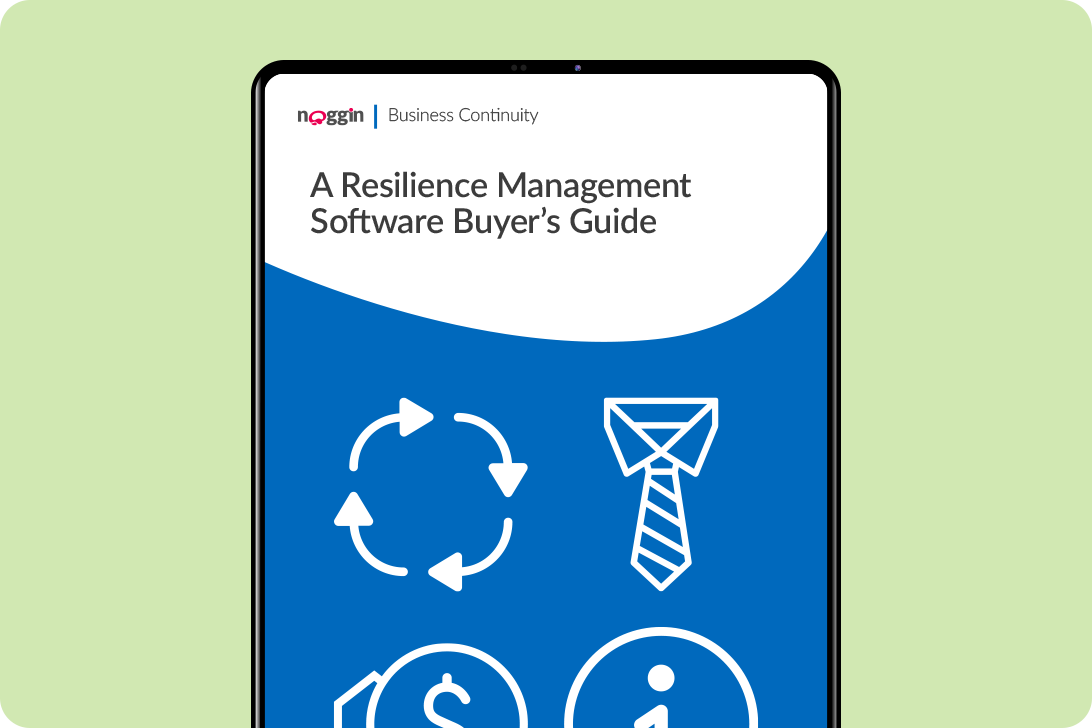Organizations today face a litany of challenges to resilience, with the popularity of the hybrid workforce fragmenting incident response, as well. What can be done to bet...
Request a Demo
Fill in the form below and we will contact you shortly to organised your personalised demonstration of the Noggin platform.
Meet Noggin
An integrated resilience workspace that seamlessly integrates 10 core solutions into one, easy-to-use software platform.
The Noggin Platform
The world's leading integrated resilience workspace for risk and business continuity management, operational resilience, incident & crisis management, and security & safety operations.
Industries
Explore Noggin's integrated resilience software, purpose-built for any industry.
The Noggin Blog
- Home
- business continuity
business continuity
Latest Articles
4 Digital Capabilities to Consider in Business Continuity Planning Software
Companies confronting an unprecedented era of compounding, consecutive, and concurrent crises.
The question then turns to, what business continuity...
Mandatory Cyberattack Reporting: A Harbinger of the Future?
As cyberattacks increase will regulators demand mandatory cyberattack reporting?
In one sector, they likely will.
Which one? Read on to find out.
What is Crisis Communication? Crisis Communication Strategies
When crisis response goes awry, poor communication is often at fault. Poor communication typically takes any of the following forms:
- Withholding...
5 Reasons to Upgrade Your Emergency Management Platform
Organizations today face a litany of challenges to resilience, with the popularity of the hybrid workforce fragmenting incident response, as well....
Operational Risk Management: Overview & Guide
What’s one of the most significant risks businesses face today? That would be operational risk.
Don’t think so? Consider the fates of Enron,...
The Benefits of Operational Risk Management
Everyone knows that running a business involves risk. But not all risks are created equal.
Business leaders will encounter certain risks that are...
6 Types of Workplace Hazards
Workplace injuries and illnesses don’t come out of the blue. They’re often the product of workplace hazards that haven’t been successfully...
BCM Lifecyle: 6 Stages of the Business Continuity Lifecycle
In the age of constant crisis, companies understand the importance of business continuity in continuing the delivery of products or services...
What Clients Should Know about Effective Governance of Operational Resilience (OpRes)
Interest in operational resilience has no doubt boomed among your clients, whether they’re in a heavily regulated industry or not. But an OpRes...
Strategies to Protect Critical Infrastructure in Times of Heightened Threat
Attacks on critical infrastructure assets are on the rise. And now, national publics are concerned. A staggering 81% of U.S. residents are worried...
6 Ways Business Continuity Management Software Can Prepare Your Organization for Any Disruption
Nowadays, disruption is a matter of when not if.
4 Digital Capabilities to Consider in Business Continuity Planning Software
Companies confronting an unprecedented era of compounding, consecutive, and concurrent crises.
The question then turns to, what business continuity...
BCM Lifecyle: 6 Stages of the Business Continuity Lifecycle
In the age of constant crisis, companies understand the importance of business continuity in continuing the delivery of products or services...
6 Ways Business Continuity Management Software Can Prepare Your Organization for Any Disruption
Nowadays, disruption is a matter of when not if.
APRA CPS 230 is Final: Here’s what you should know
An independent statutory authority, the Australian Prudential Regulation Authority (APRA) supervises financial and related institutions across the...
Business Continuity Best-Practice Guidelines for Your Clients
We’re seeing big increases in the number of organizations certified to ISO 22301. Your clients are likely to figure among those ranks. But even if...
How to Get on Top of Operational Resilience Dependency Mapping
Operational resilience is the ability to deliver operations, including critical operations and core business lines, through a disruption from any...
What Your Clients Need to Know about the Business Impact Analysis
Your clients have resolved to get their business continuity house in order. Now, they have to get started on the business impact analysis (BIA), the...
8 Steps to Conducting a Business Impact Analysis (BIA)
For businesses, risk is everywhere – from supply chains to cyberattacks to severe weather and the cost of living. What can businesses do to get ahead...
Getting Started with Business Continuity Testing
75% of businesses without a business continuity plan (BCP) fail three years after disaster. But in 2024, an untested BCP won’t offer much in the way...
Best Practices for Business Continuity Plan Testing
The business continuity plan (BCP) is critical to business resilience. Indeed, the insurance brokerage, Gallagher estimates that more than 70% of...
What Is Third-Party Risk Management (TPRM)?
A form of risk management, third-party risk management is the continuing process of identifying, analyzing, evaluating, and treating risks related to...
What Your Clients Need to Know about Third-Party Risk Management?
By now, your clients likely have a solid handle on risk management. But what about their third-party risk? Third-party risk management (TPRM) isn’t...




